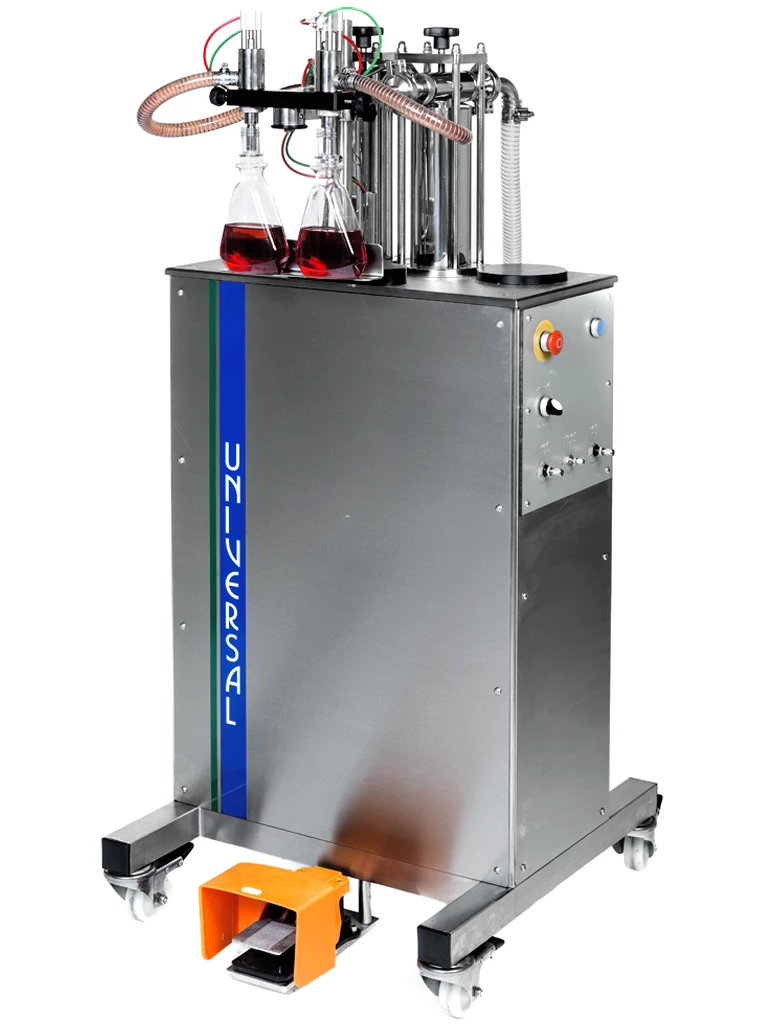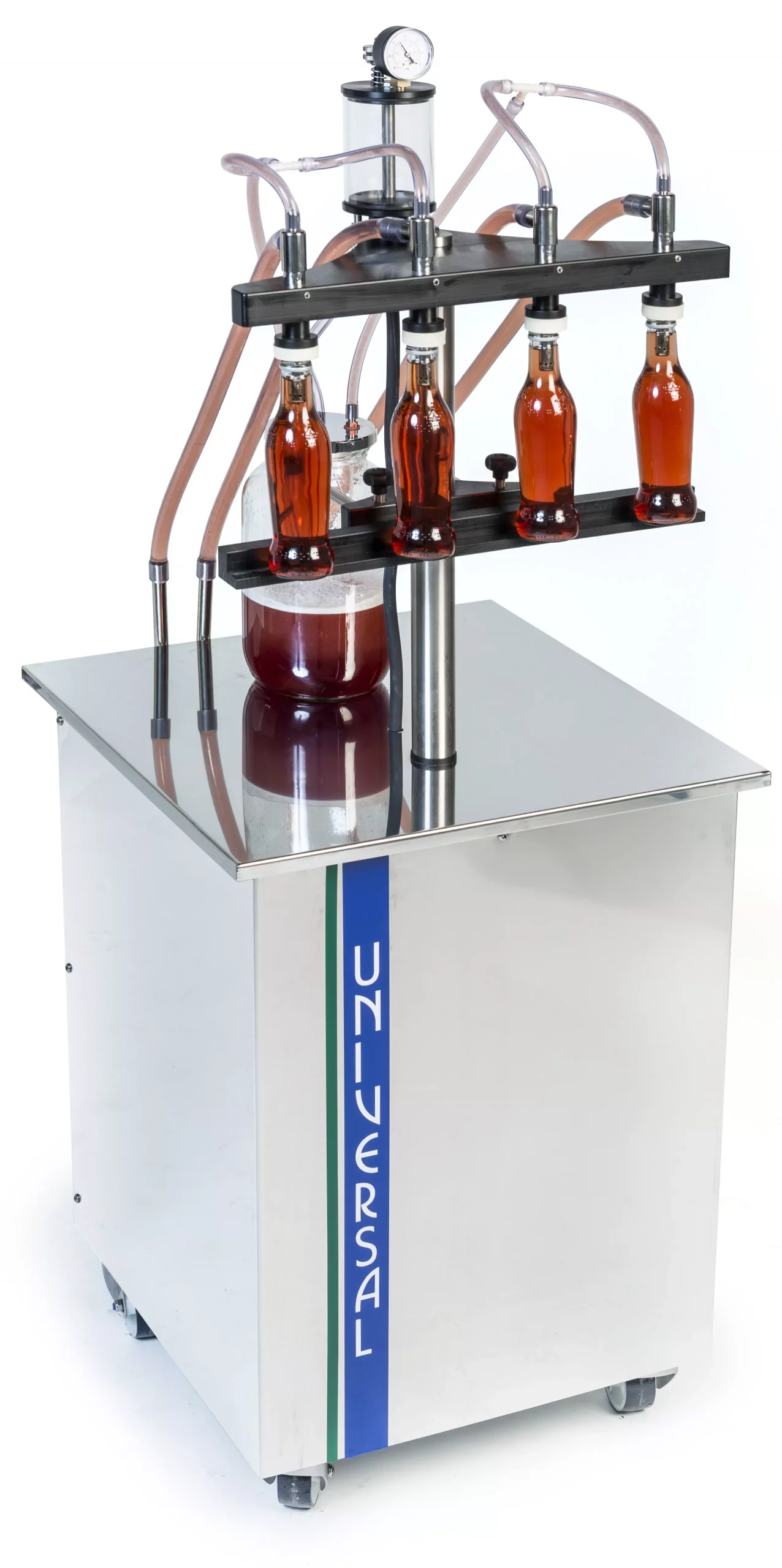Two distinct filling technologies are available for semi-automatic and fully automatic filling machines: volumetric and vacuum-level filling.
Manually operated filling machines tend only to fill volumetrically.
Volumetric filling machines
Manual liquid filling machines use a piston within a cylinder to force liquid into the container.
These normally have a pneumatically powered pump mechanism, set to fill containers with the required volume of liquid, fed from either a floor-standing container or a machine-mounted hopper.
Containers are positioned below the filling nozzles and a foot pedal switch to start the filling process.
Volumes between 5ml and 25-litres can be handled by volumetric filling machines and up to 150 containers per minute can be filled, depending on the fill volume, liquid viscosity and level of machine automation.

Vacuum level filling machines
Vacuum level semi-automatic filling machines use the rim at the top of the container to form an airtight seal around the filling nozzle.
This airtight seal creates a vacuum within the bottle which draws free-flowing liquids from a supply tank into the bottle, via specially designed nozzles. These nozzles have a small hole on the side which is connected to a small internal tube.
The height of this hole in relation to the top of the container during filling determines the level of liquid dispensed. The small hole in the nozzle scavenges excess liquid from the filling process and collects it in a receiver for reuse.
Vacuum level filling machines fill containers to the same height each time, rather than dispensing the same volume. This is particularly useful for glass bottles which will be side-by-side on display shelves in shops. Glass bottles vary in capacity quite a lot, yet vacuum-level filling ensures the level each bottle is filled to is the same, giving a consistent appearance from one bottle to the next. Vacuum level filling requires rigid containers which won’t collapse under a vacuum.

Vacuum-level machines have virtually no moving parts, making them incredibly reliable, and can fill up to 120 bottles per minute depending on the container type, number of filling heads and level of automation.
Bottles are simply positioned with their top in contact with a sealing ring around the nozzle. The container will start to fill as soon as an airtight seal is made and stop when the pre-determined fill height is reached.
Two distinct filling technologies are available for semi-automatic and fully automatic filling machines: volumetric and vacuum-level filling.
Manually operated filling machines tend only to fill volumetrically.
Volumetric filling machines
Manual liquid filling machines use a piston within a cylinder to force liquid into the container.
These normally have a pneumatically powered pump mechanism, set to fill containers with the required volume of liquid, fed from either a floor-standing container or a machine-mounted hopper.
Containers are positioned below the filling nozzles and a foot pedal switch to start the filling process.
Volumes between 5ml and 25-litres can be handled by volumetric filling machines and up to 150 containers per minute can be filled, depending on the fill volume, liquid viscosity and level of machine automation.

Vacuum level filling machines
Vacuum level semi-automatic filling machines use the rim at the top of the container to form an airtight seal around the filling nozzle.

This airtight seal creates a vacuum within the bottle which draws free-flowing liquids from a supply tank into the bottle, via specially designed nozzles. These nozzles have a small hole on the side which is connected to a small internal tube.
The height of this hole in relation to the top of the container during filling determines the level of liquid dispensed. The small hole in the nozzle scavenges excess liquid from the filling process and collects it in a receiver for reuse.
Vacuum level filling machines fill containers to the same height each time, rather than dispensing the same volume. This is particularly useful for glass bottles which will be side-by-side on display shelves in shops. Glass bottles vary in capacity quite a lot, yet vacuum-level filling ensures the level each bottle is filled to is the same, giving a consistent appearance from one bottle to the next. Vacuum level filling requires rigid containers which won’t collapse under a vacuum.
Vacuum-level machines have virtually no moving parts, making them incredibly reliable, and can fill up to 120 bottles per minute depending on the container type, number of filling heads and level of automation.
Bottles are simply positioned with their top in contact with a sealing ring around the nozzle. The container will start to fill as soon as an airtight seal is made and stop when the pre-determined fill height is reached.
Vacuum level filling is a type of liquid filling method that uses a vacuum to draw liquid into containers.
In this method, the container is first placed under a filling nozzle, and a vacuum is applied to the container.
This creates a low-pressure environment inside the container, which draws the liquid from the reservoir into the container. Once the desired fill level is reached, the vacuum is released, and the filling nozzle is withdrawn from the container.
Vacuum level filling is commonly used for filling containers with low to medium viscosity liquids, such as oils, perfumes, and solvents. This method is particularly useful for filling containers with small openings or narrow necks, where other filling methods may not be suitable. Vacuum level filling is also known for its accuracy and consistency, as the vacuum pressure can be precisely controlled to ensure a consistent fill level in each container.
Here is an example of how vacuum level filling works in practice:
Let’s say you are filling a small bottle with a low-viscosity liquid, such as perfume. You have a vacuum level filling machine set up with filling nozzles and a reservoir containing the perfume.
To fill the bottle, you would first place it under the filling nozzle, with the nozzle inserted into the bottle’s opening. The white foam pads around the nozzle form an airtight seal with the bottle, which creates a low-pressure environment inside the bottle.
As the vacuum draws air out of the bottle, it also creates a suction effect on the liquid in the reservoir. This causes the liquid to flow through the filling nozzle and into the bottle, filling it up to the desired level, as dictated by the small hole in the side of the nozzle.
Filling is complete when the level of liquid in the bottle reaches the small hole in the side of the nozzle which draws the vacuum.
The bottle is now filled with the desired amount of liquid, and the vacuum level filling process is complete.
Any excess liquid is drawn up the small hole in the side of the nozzle and captured in a scavenger jar or tank for re-use.
Overall, vacuum level filling is a precise and efficient way to fill containers with low to medium viscosity liquids, and is commonly used in the cosmetic, pharmaceutical, and chemical industries.
